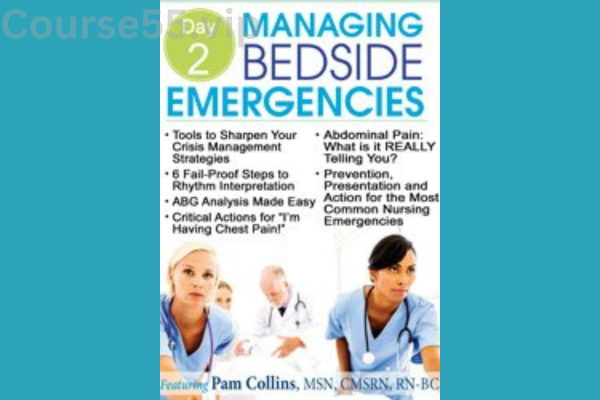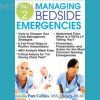Key Interventions & Documentation Strategies During a Patient Emergency By Pam Collins – PESI
$99.00 Original price was: $99.00.$23.10Current price is: $23.10.
Key Interventions and Documentation Strategies During a Patient Emergency by Pam Collins – Digital Download!

Key Interventions & Documentation Strategies During a Patient Emergency By Pam Collins – PESI
Overview

Pam Collins’ Approach to Critical Emergency Interventions and Documentation Practices
Emergencies in healthcare settings are unpredictable, often catching professionals by surprise. Understanding the importance of proper intervention and detailed documentation during such moments, Pam Collins has developed a comprehensive course titled Key Interventions & Documentation Strategies During a Patient Emergency. This course is designed for healthcare providers seeking to improve their crisis management abilities, offering valuable skills and strategies for efficient patient care during emergencies.
The curriculum focuses on recognizing early signs of distress, implementing critical interventions, and emphasizing the importance of detailed documentation. This multifaceted approach not only ensures prompt patient care but also serves to protect healthcare providers in potential legal circumstances—particularly important in today’s litigious healthcare environment.
Understanding the Fundamentals of Medical Emergencies
Grasping the fundamentals of medical emergencies is crucial for providing effective care during critical situations. Collins highlights the importance of recognizing subtle signs of deteriorating health, which can often be missed by untrained observers. For instance, signs of a stroke, such as mild confusion or unilateral weakness, may be overlooked. Early recognition is vital, as conditions like strokes, heart attacks, gastrointestinal bleeds, ARDS, and shock require immediate action.
The course stresses the need for vigilant monitoring of vital signs, such as heart rate and blood pressure, which can help detect abnormalities that may indicate a life-threatening situation. By referencing real-life case studies, participants are shown how early intervention has led to better patient outcomes, underscoring the value of timely recognition.
Additionally, understanding emergencies encompasses not just recognizing physical symptoms, but also acknowledging the psychological impact on patients and their families. Effective communication is essential in reassuring patients and guiding their families through uncertain times, ensuring that healthcare providers address both the medical and emotional aspects of the crisis.
Crucial Interventions During Patient Emergencies
The course then delves into the critical interventions necessary during medical emergencies, with a focus on respiratory distress, post-operative complications, and high-risk scenarios. In respiratory emergencies like pneumonia or pulmonary embolism, it is essential to interpret arterial blood gases (ABGs), which are key to assessing oxygenation and acid-base balance. This knowledge helps healthcare providers decide on the correct interventions and monitor the patient’s condition effectively.
The curriculum also covers common post-operative complications that healthcare professionals might encounter, such as uncontrolled pain, compartment syndrome, and acute kidney injury. By enhancing skills in managing these complications, healthcare providers can improve patient recovery times and reduce the likelihood of adverse outcomes. Case studies are included to illustrate practical applications of intervention strategies.
Furthermore, key intervention strategies extend beyond physical actions; they also involve understanding patient behavior under stress. For example, sudden agitation in a patient may not just be a sign of discomfort but could indicate a more severe underlying issue. Teaching healthcare providers to identify and respond to such behaviors appropriately is vital in achieving optimal patient outcomes.
Documentation Practices for Emergencies
Accurate and thorough documentation is essential for both quality patient care and legal protection. Collins’ course emphasizes the importance of adhering to legally defensible documentation practices, particularly in emergency situations where the risk of litigation is high. Participants are taught how to document events clearly and effectively, ensuring that the patient’s care is well-documented in high-pressure environments.
Key Elements for Effective Documentation
• Clear and Precise Notes: Record every event accurately, such as the exact time medications were administered, to avoid discrepancies.
• Chronological Sequence: Document events in the order they occur to provide a clear timeline of the patient’s condition and the interventions taken.
• Legal Awareness: Understand common pitfalls in documentation and how to avoid them. For instance, it’s essential to accurately record any changes in patient status and notify appropriate medical staff when necessary.
• Clarity and Precision: Employ strategies to ensure that all documentation is clear, minimizing misunderstandings and providing a safeguard against legal challenges.
By learning to avoid common documentation errors, the course ensures that healthcare providers are prepared for potential legal scrutiny while maintaining continuity of care for patients.
Developing Critical Thinking in High-Stress Situations
Critical thinking is a vital skill that healthcare professionals must develop, especially in emergencies. Collins’ course is designed to enhance participants’ decision-making abilities, equipping them to respond effectively to unpredictable patient behaviors and subtle signs of distress.
Real-life scenarios are used to illustrate the importance of critical thinking. For instance, a patient who appears calm may still be at risk if their underlying medical conditions are not addressed. Healthcare providers trained to look beyond the surface can better handle these situations and make timely interventions.
Building Critical Thinking Skills
• Scenario-Based Learning: Engage in simulations and discussions centered on emergency situations, enhancing critical thinking abilities.
• Team-Based Problem Solving: Foster a collaborative environment where healthcare providers can exchange ideas, leading to comprehensive and informed solutions.
This focus on both interventions and the thought processes behind them ensures that healthcare professionals are equipped to not only react to emergencies but also anticipate complications and act proactively to prevent crises.
Learning Outcomes from the Course
Upon completing the course, participants will be better prepared to manage emergencies with confidence, demonstrating enhanced clinical decision-making and legal documentation skills. The course aims to ensure that healthcare professionals are not only capable of responding to emergencies effectively but are also well-prepared for any legal challenges that may arise.
The expected learning outcomes include:
• Improved Clinical Decision-Making: Healthcare providers will feel more confident in managing emergencies across a range of specialties.
• Enhanced Documentation Skills: Participants will gain a clear understanding of the legal implications of documentation, helping to protect their careers in potential legal situations.
• Greater Awareness of Patient Behavior: A deeper understanding of how patients behave in emergencies will lead to better preparedness and improved patient outcomes.
Conclusion
Pam Collins’ course on Key Interventions & Documentation Strategies During a Patient Emergency offers a comprehensive educational resource for healthcare professionals. By focusing on emergency recognition, critical interventions, and thorough documentation practices, the course is indispensable for those looking to enhance their expertise in handling medical crises. This training not only equips healthcare providers to manage emergencies effectively but also provides legal protection, ensuring that they can offer high-quality patient care in a secure, legally compliant environment. The essential skills learned throughout the course emphasize that proactive actions and precise documentation are key to improving patient care.
Frequently Asked Questions:
Business Model Innovation: We operate a group buying strategy, allowing participants to share costs and access popular courses at reduced prices. This model benefits individuals with limited financial resources, despite concerns from content creators about distribution methods.
Legal Considerations: The legality of our operations involves complex issues. Although we don’t have explicit permission from course creators to resell their content, there are no specific resale restrictions stated at the time of purchase. This ambiguity creates an opportunity for us to provide affordable educational resources.
Quality Control: We ensure that all course materials purchased are identical to those offered directly by the creators. However, it’s important to understand that we are not official providers. As such, our offerings do not include:
– Live coaching calls or sessions with the course author.
– Access to exclusive author-controlled groups or portals.
– Membership in private forums.
– Direct email support from the author or their team.
We aim to reduce the cost barrier in education by offering these courses independently, without the premium services available through official channels. We appreciate your understanding of our unique approach.
Be the first to review “Key Interventions & Documentation Strategies During a Patient Emergency By Pam Collins – PESI” Cancel reply
You must be logged in to post a review.

 Legal Issues in Behavioral Health Maryland: Legal and Ethical Considerations By Lois Fenner - PESI
Legal Issues in Behavioral Health Maryland: Legal and Ethical Considerations By Lois Fenner - PESI 














Reviews
There are no reviews yet.